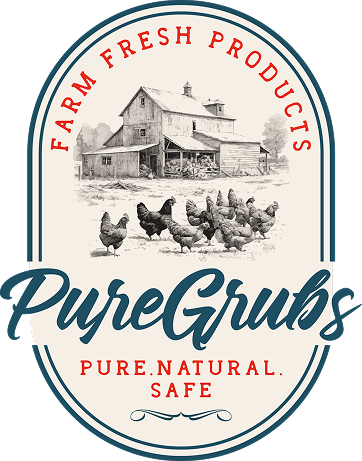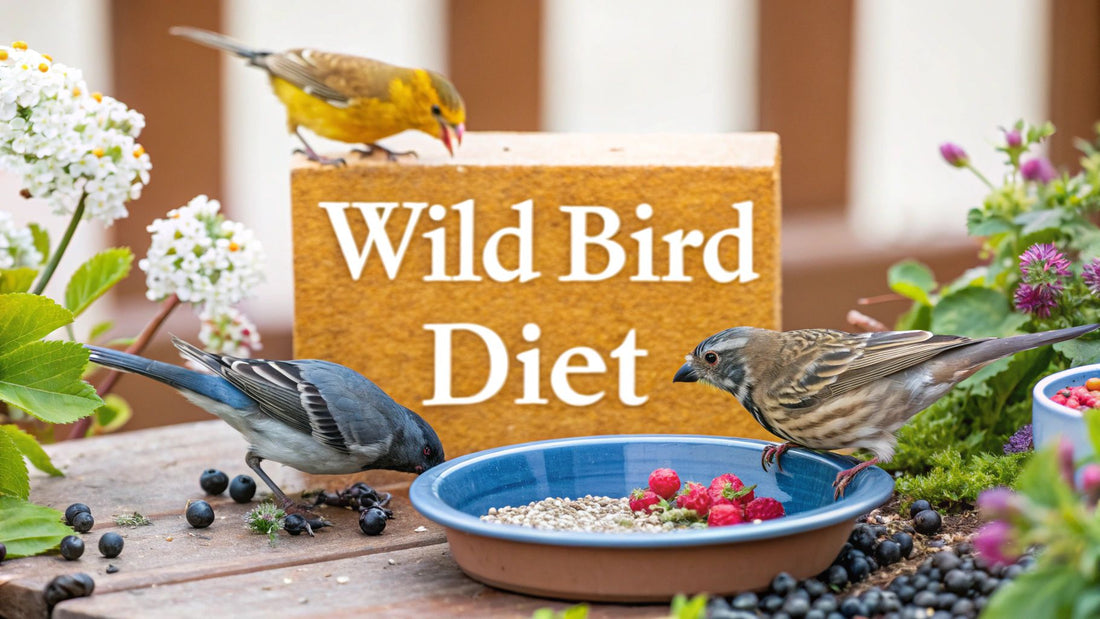
What Do Wild Birds Eat? A Complete Feeding Guide
Share
So, what do wild birds actually eat? You might think seeds and worms, and you wouldn't be wrong, but that's just scratching the surface. The real answer is a vibrant mix of insects, seeds, fruits, and nectar, all dictated by the bird's species, the time of year, and where it lives.
A Bird's Menu: An Introduction to Their Diet
Think of a wild bird as a tiny, high-performance athlete. Its entire day is spent in constant motion, and that requires the right kind of fuel. But unlike us, birds can't just eat anything; they're specialists. Their beaks, feet, and even their digestive systems are perfectly designed for a specific menu, which is exactly why you see certain birds at your feeder and not others.
We can group birds by what they primarily eat. This isn't just trivia for bird nerds—it’s the core of their survival strategy. Each group has developed incredible adaptations to find and eat their favorite foods.
The Main Dietary Groups
To really understand what's happening in your backyard, it helps to know the major players. While many birds are omnivores and will dabble in different foods, most have a clear preference that drives their behavior.
- Insectivores (The Bug Eaters): These are nature's pest control experts. Think of swallows, warblers, and woodpeckers—they're always on the hunt for insects, spiders, and other creepy crawlies. This protein-packed diet is absolutely essential during nesting season to help their babies grow.
- Granivores (The Seed Specialists): With their strong, cone-shaped beaks, birds like finches, sparrows, and cardinals are masters at cracking open tough seeds. These are the regulars at your feeders, happily munching on sunflower, thistle, and millet.
- Frugivores (The Fruit Fans): Robins, waxwings, and orioles have a serious sweet tooth for berries and other fruits. As a bonus, they act as tiny gardeners, spreading seeds far and wide as they eat.
- Nectarivores (The Sugar Sippers): The hummingbird is the poster child for this group. Its entire body is built to run on the high-octane sugar found in flower nectar. That long, skinny beak and specialized tongue? They're the perfect tools for the job.
Getting a handle on these dietary groups is your first step toward becoming a better backyard bird-watcher. When you know what different birds eat, you can offer the right foods to attract a stunning variety and give them the support they need all year long.
This breakdown helps make sense of all the activity you see outside. That woodpecker hammering away on a tree isn't just making a racket; it's digging for insect larvae. A goldfinch dangling from a coneflower is carefully plucking out each seed. Every single action is part of a daily mission to find food—a mission powered by a diet perfectly suited to their way of life.
Let's take a look at a quick summary.
Quick Guide to Common Bird Diets
This table gives you a snapshot of which birds eat what. It’s a great starting point for identifying your local visitors and figuring out what to put in your feeders.
| Bird Type (Diet) | Primary Food Sources | Common Examples |
|---|---|---|
| Insectivore | Insects, spiders, larvae, snails | Warblers, Swallows, Woodpeckers, Wrens |
| Granivore | Seeds, grains, nuts | Finches, Sparrows, Cardinals, Grosbeaks |
| Frugivore | Fruits, berries | Robins, Waxwings, Bluebirds, Orioles |
| Nectarivore | Flower nectar, tree sap, tiny insects | Hummingbirds, some Woodpeckers (sap) |
| Omnivore | A mix of seeds, insects, and fruits | Jays, Crows, Chickadees, Starlings |
As you can see, while some birds are specialists, others like the Chickadee are happy to mix it up. This flexibility is another key to their survival. In the rest of this guide, we'll dive deeper into these diets to uncover the fascinating links between birds and their food.
How a Bird's Diet Changes With the Seasons
For wild birds, survival is all about adapting, and their diet is at the heart of that strategy. Think about it: if you could only eat what was naturally available outside your door for a whole year, your meals would change dramatically from May to December. That's a bird's reality, and they are masters at shifting their diets to match nature’s ever-changing pantry.
This constant adjustment comes down to two simple but powerful forces: energy needs and food availability. A bird's life is a high-stakes balancing act of finding enough fuel to survive the day, raise a family, or power a thousand-mile journey.
Spring: The Protein Rush
Spring is a whirlwind of activity. As temperatures climb, insects hatch by the millions, creating a massive, protein-packed buffet. This isn't just a lucky break for birds; it's the critical fuel they need to handle the exhausting demands of breeding season.
Protein is the ultimate building block for growth. Parent birds are on a relentless hunt from dawn to dusk, snatching up caterpillars, spiders, and other bugs to feed their fast-growing chicks. For many species, an insect-based diet is absolutely essential for raising a healthy brood.
You can think of insects as the perfect baby food for birds. Even a finch that eats seeds most of the year will switch to catching bugs almost exclusively. Why? Because its nestlings need those high-protein meals to develop strong bones and feathers.
Autumn and Winter: Preparing for the Lean Times
Once summer fades and autumn rolls in, the insect population plummets, and the menu shifts again. Now, birds turn their focus to high-energy foods that help them pack on the fat. This is the season for gorging on berries, fruits, and seeds, all of which are loaded with fats and carbohydrates.
For migratory birds, this is the fuel that powers their incredible long-distance flights. For the birds that stick around, it’s all about building up fat reserves to survive the cold months ahead. The question of "what do wild birds eat?" suddenly becomes a matter of finding the most calorie-dense option available.
This infographic really shows the dramatic shift in what birds are eating throughout the year.
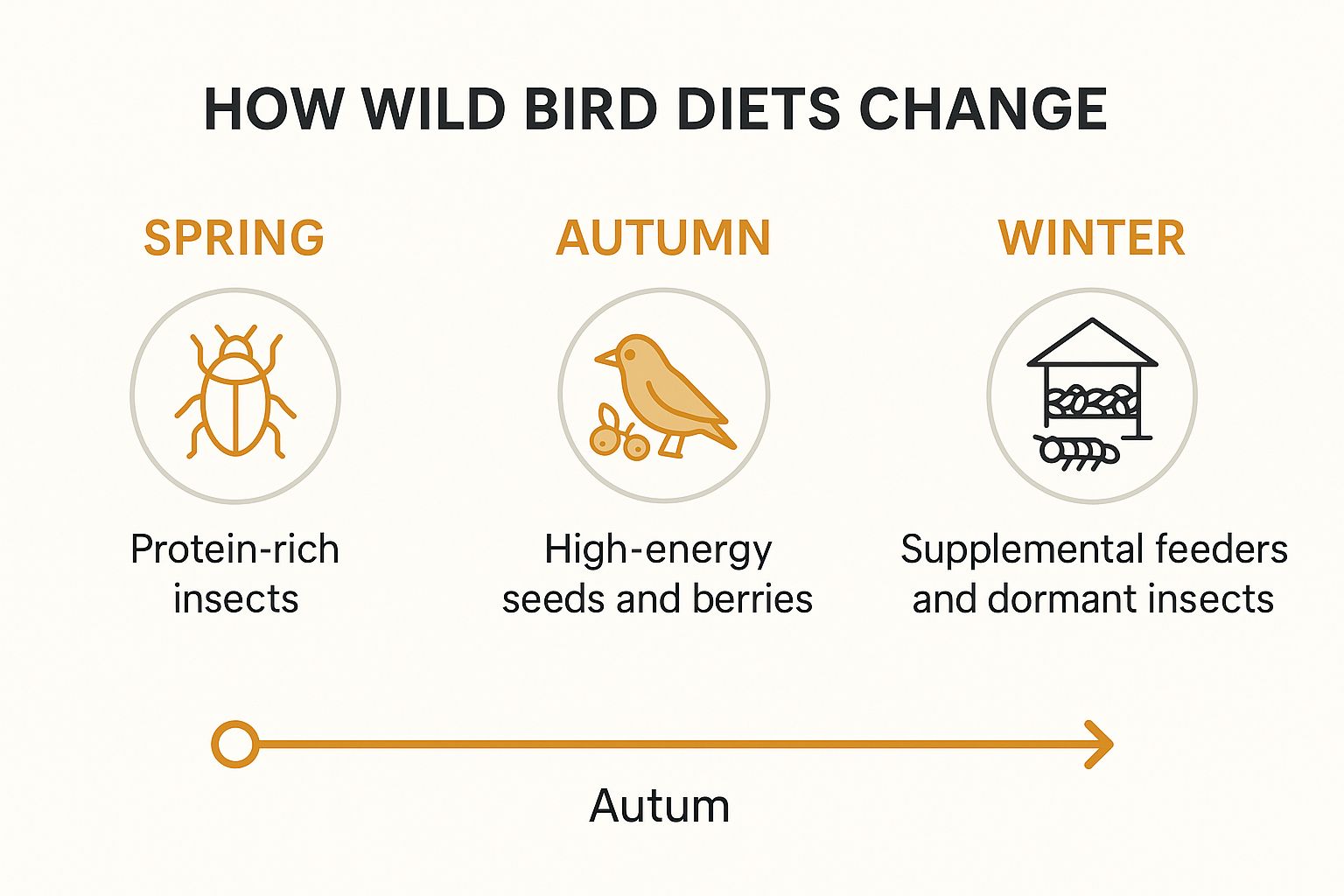
You can clearly see how they move from a protein-heavy diet in the spring to energy-rich foods in the fall and winter. It’s a fantastic illustration of their remarkable ability to adapt.
Winter, of course, presents the biggest challenge of all. Natural food becomes incredibly scarce, and birds have to become expert foragers. They'll spend their days searching for:
- Leftover Seeds and Berries: Picking through whatever remains from autumn's harvest.
- Dormant Insects: Meticulously checking tree bark and leaf litter for hibernating insects or their eggs.
- Supplemental Feeders: This is where we come in. Backyard feeders provide a reliable, high-energy source of food like suet and sunflower seeds when natural options are buried under snow and ice.
When you understand these seasonal dietary shifts, you're so much better equipped to support your local birds. By offering the right foods at the right times, you can give them the critical resources they need to not just survive, but thrive all year long.
The Insect Eaters: Nature's Expert Pest Controllers
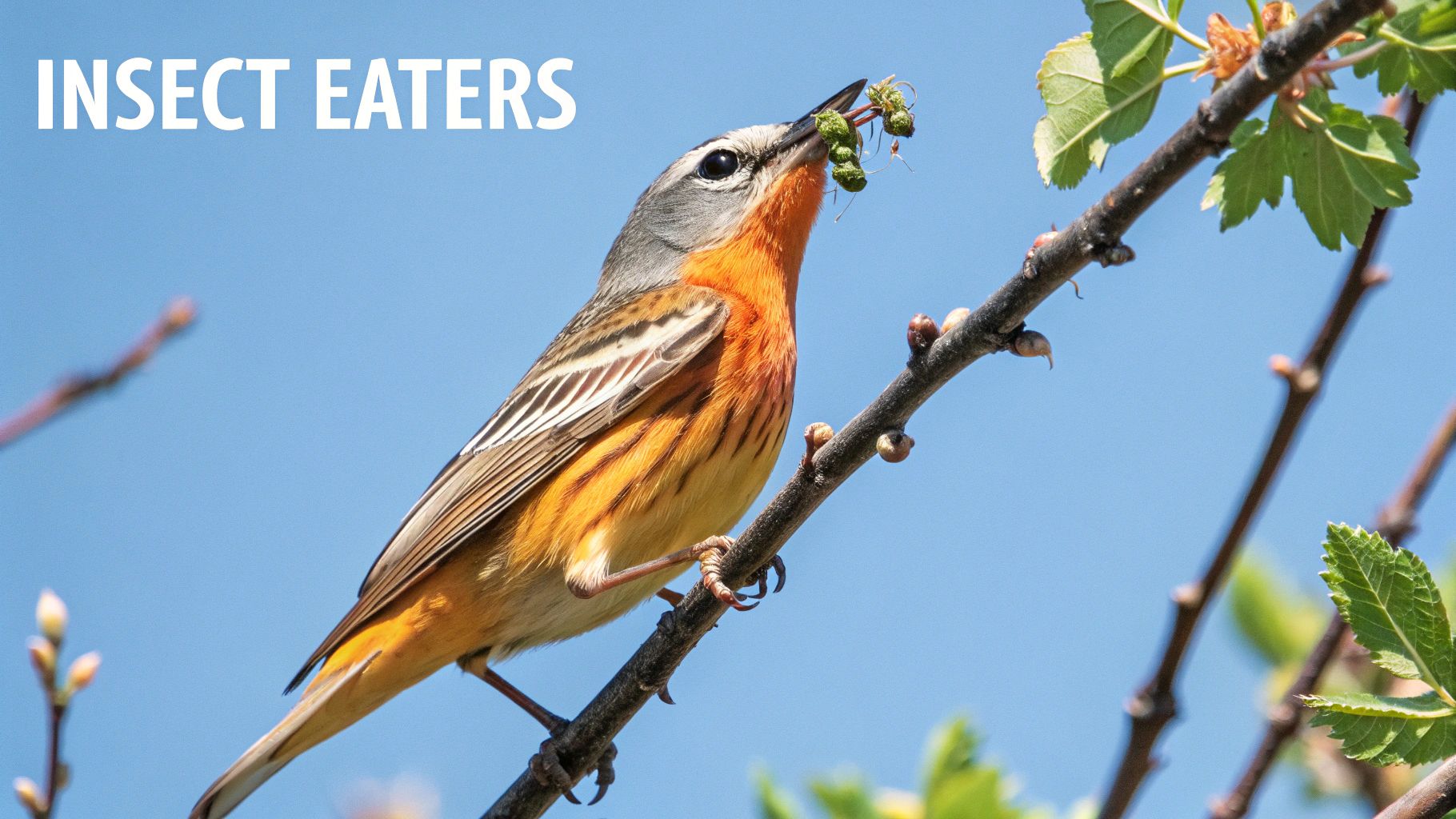
When we picture feeding wild birds, seeds and berries are usually the first things that come to mind. But a massive part of the avian world operates as nature's most efficient pest control crew. These are the insectivores—the tireless aerial acrobats and branch-hopping hunters that fuel up on insects, spiders, and other invertebrates.
From the warblers you see flitting through the treetops to the swallows that dive gracefully over open fields, these birds play a huge, often unnoticed, role in keeping our ecosystems in balance. Their diet isn't just a matter of preference; it's a critical service that helps protect our forests, farms, and even our own backyards from being overrun.
The Power of a Protein-Packed Diet
For an insect-eating bird, a bug is the ultimate superfood. It’s loaded with the protein and fats they need to power high-energy activities like migrating thousands of miles or raising a brood of hungry chicks.
This becomes especially critical during the spring breeding season. Parent birds are on a constant mission to find enough protein-rich insects to fuel the explosive growth of their nestlings. In fact, even birds we think of as seed-eaters, like finches, will often pivot to an insect-heavy diet to feed their young. Without this incredible food source, many bird populations would simply struggle to reproduce.
The sheer scale of their collective appetite is astounding. Global research estimates that insect-eating birds consume somewhere between 400 and 500 million metric tons of prey every single year. A staggering 70% of that happens in forested areas, which just goes to show how vital they are to the health of these habitats. You can dig into the ecological impact of these avian predators and their diets in the full study.
Specialized Tools for the Hunt
Insect-eating birds have evolved some incredible tools for the job. You can see it in their beaks, which are perfectly shaped for catching their preferred meals:
- Thin, Pointed Beaks: Think of warblers and wrens. They have delicate, tweezer-like bills that are perfect for plucking tiny insects and spiders off leaves and out of bark crevices.
- Wide, Gaping Mouths: Swallows and swifts essentially have built-in nets. They fly with their wide mouths open, scooping up flying insects right out of the air.
- Strong, Chisel-Like Beaks: Woodpeckers are the demolition experts. They use their powerful beaks to drill into wood and pull out the juicy larvae hidden deep inside.
By offering supplemental foods that mimic their natural diet, like dried Black Soldier Fly Larvae, you can give these amazing birds a much-needed protein boost. Knowing where to buy black soldier fly larvae helps you find high-quality options to support your feathered visitors, giving them the extra energy they need to continue their important work.
The Plant-Powered Diets of Birds
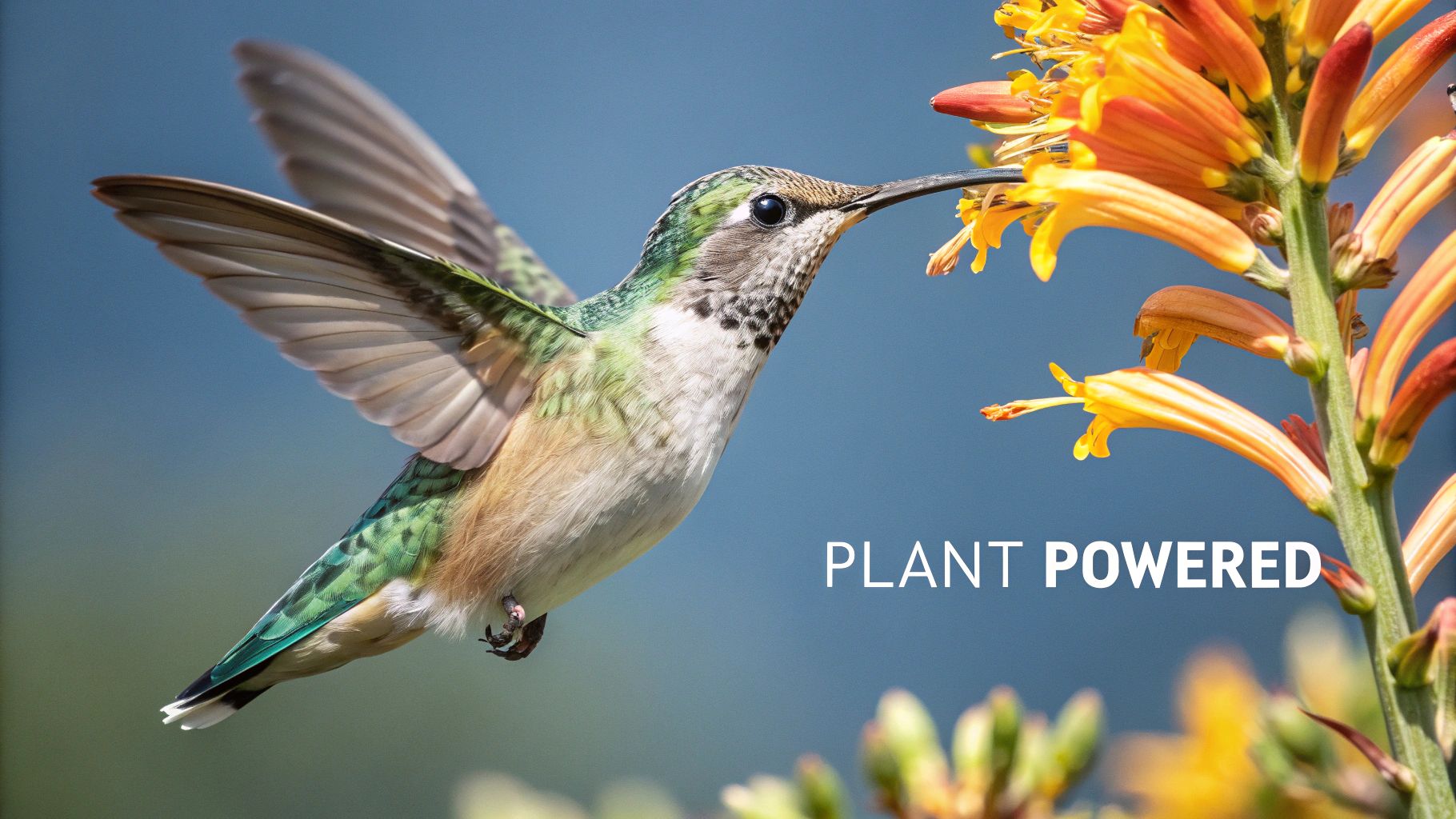
While insects are a fantastic source of protein, many bird species are built to run on the incredible variety the plant kingdom offers. From seeds and fruits to nectar, plants provide the essential carbs and fats that serve as high-energy fuel. This is what powers everything from a finch’s cheerful song to a hummingbird's stunning aerial acrobatics.
This beautiful, symbiotic dance between birds and plants is constantly shaping the world around us. Let's break down these plant-powered birds into a few key groups, each with its own specialized tools for the job.
Granivores: The Seed-Cracking Specialists
First up are the granivores, the classic seed-eaters. If you have a backyard feeder, you know these birds well—finches, sparrows, and cardinals are masters at cracking tough shells to get to the nutritious prize inside.
Think of their beaks as nature’s built-in nutcrackers. A grosbeak’s heavy, powerful bill can make quick work of a large sunflower seed, while a tiny goldfinch’s delicate beak is perfectly shaped for plucking out Nyjer seeds. For them, seeds are concentrated packets of energy, which is why they're such a critical food source when insects disappear in the cold winter months. Knowing what to offer wild birds is a lot like knowing what to give your own flock; for instance, understanding appropriate snacks for chickens helps you provide the best nutrition.
Frugivores: Nature’s Tiny Gardeners
Next, we have the frugivores, or fruit-eaters. Species like robins, cedar waxwings, and orioles have a real sweet tooth, feasting on berries, crabapples, and other soft fruits. But this isn't just a one-sided meal—it’s a vital partnership that plants rely on.
When a frugivore eats a berry, it digests the sweet pulp and passes the seed. Later, it excretes that seed, often miles from the parent plant. This process, known as seed dispersal, effectively makes these birds the gardeners of our ecosystems, helping to plant new trees and shrubs.
You’ll notice their beaks are typically softer and wider than a seed-eater's, designed for gulping down fruit whole. It's a perfect example of a relationship where both the bird and the plant come out ahead.
Nectarivores: The High-Octane Sippers
Finally, let's talk about the incredible nectarivores, and there’s no better example than the hummingbird. These birds live life in the fast lane, with unbelievably high metabolic rates that demand a constant source of simple sugars just to keep going. For them, flower nectar is pure rocket fuel.
A hummingbird’s entire body is a marvel of specialization. Its long, slender bill and unique, grooved tongue work like a tiny, hyper-efficient straw to draw nectar from deep within a flower's bell. To round out their sugar-heavy diet, they also snatch tiny insects and spiders right out of the air, getting the protein they need to power their energetic lifestyle.
How Much Food Do Birds Really Need to Survive
Have you ever watched a tiny chickadee darting around and wondered where it gets all that energy? The secret is an incredibly high metabolism. It’s like a tiny furnace burning through fuel at a shocking rate, which is why a bird's search for food is so constant and relentless.
To make it through a single day—let alone a cold night—a bird has to eat a surprising amount of food for its size. Think of it like a small car with a tiny gas tank; it needs to refuel far more often than a big truck. Small birds have very little fat to fall back on, so they must eat continuously just to keep their internal engine running.
This constant need for fuel gets even more intense when the weather turns cold. Birds have to burn even more calories just to stay warm, turning their daily search for food into a high-stakes race against the clock.
A Numbers Game of Survival
So, how much do they actually eat? It really depends on the bird's size, the time of year, and what they're up to. The differences can be pretty remarkable. Small songbirds, for instance, have some of the highest metabolic demands in the entire animal kingdom.
Wild birds' dietary intake varies remarkably depending on species, body size, and environmental factors. For instance, small birds like chickadees consume around 35% of their body weight in food daily, while medium-sized birds like Blue Jays eat about 10%.
This is why offering high-energy foods at your feeder makes such a huge difference. Foods packed with fats and calcium provide the concentrated fuel they need to survive, especially during nesting season when they're feeding a brood of hungry chicks. Just like with backyard flocks, providing the right nutrients is key—offering the best calcium supplement for chickens makes a world of difference for eggshell strength, and the same principle applies to wild birds.
The Extremes of Energy Consumption
If you want to see this metabolic demand in its most extreme form, just look at hummingbirds. These tiny dynamos live life in the fast lane, with wings that can beat up to 80 times per second.
To power that incredible lifestyle, a hummingbird has to consume nearly 100% of its body weight in nectar and insects every single day. Their diet is a perfect example of what wild birds need to survive: a precise mix of high-energy sugars from nectar and essential proteins from insects. They’ll supplement their sugar intake by catching up to 2,000 tiny insects a day to get the nutrients they need for feather and muscle health.
Our Growing Impact on Wild Bird Diets
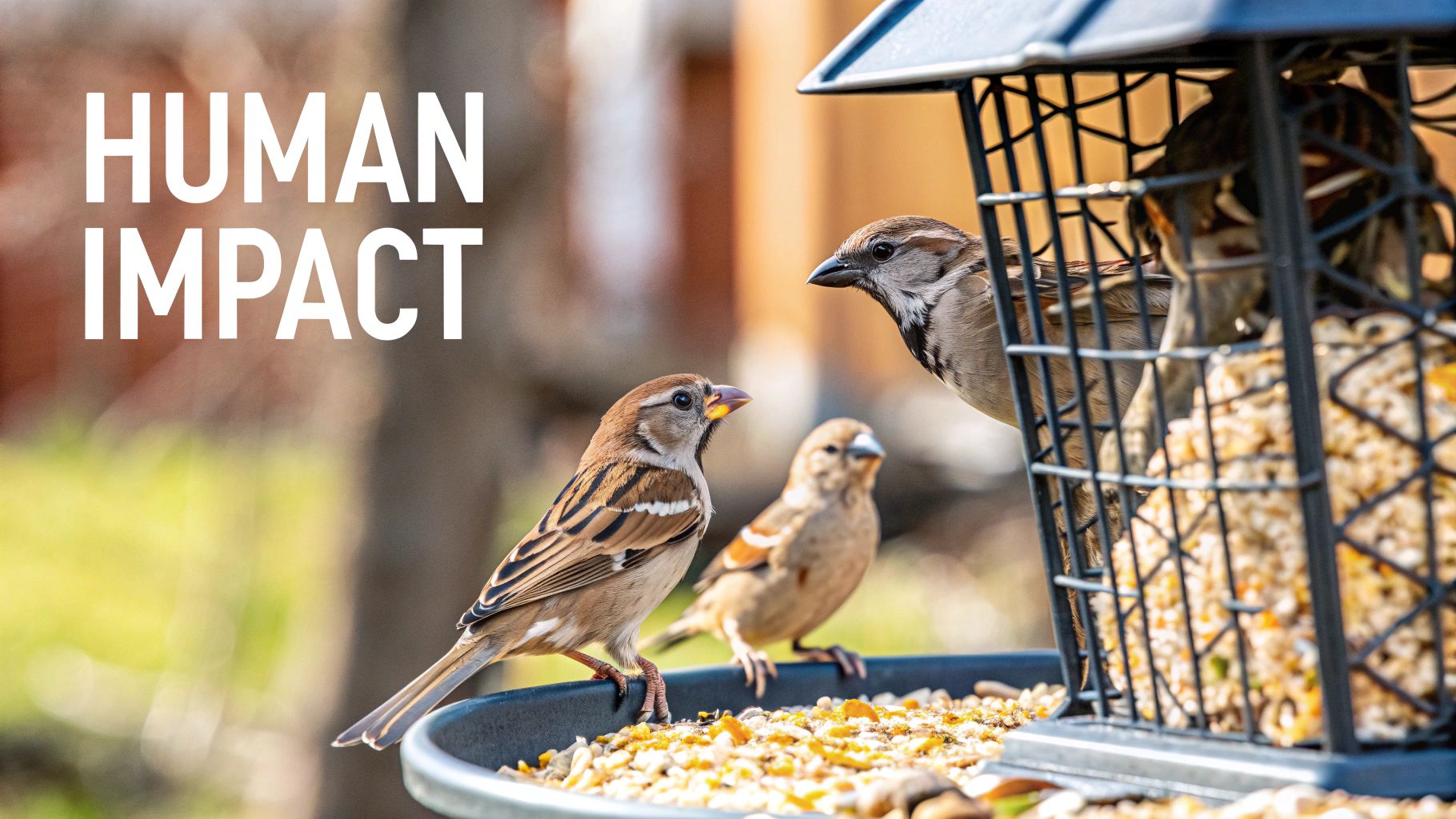
As our neighborhoods grow and natural spaces shrink, our own backyards have become surprisingly crucial habitats for wild birds. This change has put many of us in an unexpected but important role: we're now caretakers, and the choices we make—especially when it comes to feeding—have a real, direct effect on local bird populations.
Putting out a feeder can be an absolute lifeline for birds. In cities and suburbs where flowers, seeds, and insects are harder to find, a reliable food source makes a world of difference. It provides the high-energy fuel needed to survive a brutal winter or a sudden spring freeze, and it gives frantic parents a much-needed assist when their nestlings are crying out for food.
But this new relationship we've built with our feathered neighbors is complicated. To truly understand what wild birds eat, we have to look at our own influence on their diet, for better and for worse.
The Double-Edged Sword of Feeding
While our intentions are good, feeding birds comes with some serious responsibilities. A crowded, dirty feeder can quickly turn from a helpful resource into a hotspot for spreading diseases. And there's always the debate about whether we're making birds too dependent on us, potentially dulling their natural instincts to find food on their own.
The key is to be a responsible and mindful caretaker. Our goal should be to supplement a bird’s natural diet, not replace it entirely. This approach helps ensure that our good intentions translate into genuinely positive outcomes for the birds we enjoy watching.
There's no doubt that backyard bird feeding is more popular than ever. During the global pandemic, for instance, searches for bird feeding information shot up in 115 countries as people sought a connection with nature right outside their windows. This surge shows just how much human-provided food has become part of the modern bird's diet. If you're curious about the data, you can read the full research on bird feeding trends and their ecological effects on nature.com.
By keeping these factors in mind, we can make smarter choices. It means committing to clean feeders, offering high-quality food, and planting native flowers and shrubs that provide natural food sources. It's about finding a balance that lets us support local birdlife in a way that’s sustainable and truly helpful, turning our backyards into safe, healthy sanctuaries.
Got Questions About Feeding Wild Birds? Let's Clear Things Up.
Once you start learning about what birds eat out in the wild, it's only natural to have questions about how we can best support them in our own backyards. Let's tackle some of the most common things people ask so you can feed your local birds with confidence.
What Foods Are a "No-Go" for Wild Birds?
It's just as important to know what not to put out as what to offer. First and foremost, you should never feed birds bread. It's basically junk food for them, offering zero real nutrition and can even cause serious health issues.
Here are a few other things to keep off the menu:
- Anything salted, like roasted nuts or seeds from your pantry
- Uncooked rice or beans, which can be harmful
- Human treats like chocolate or avocado
- Any food that has spoiled or shows signs of mold
Your best bet is to always stick to high-quality birdseed, suet, and properly prepared nectar. That's how you keep your feathered friends healthy and coming back for more.
Should I Keep My Feeders Stocked All Year?
Absolutely. It's perfectly fine—and often a huge help—to feed birds throughout the year, as long as you're committed to keeping your feeders clean. Birds don't become dependent; they simply use our feeders to supplement what they find naturally.
Feeding in the winter is obviously critical when natural food is scarce. But keeping them full in the spring and summer helps tired parents find enough food for their hungry chicks. The two most important rules are consistency and cleanliness.
The real secret to a bustling backyard bird sanctuary is variety. If you want to see more species, offer different foods in different types of feeders. Black-oil sunflower seeds are a crowd-pleaser for almost everyone, while suet cakes are a magnet for woodpeckers, nuthatches, and chickadees. And don't forget—a clean, reliable water source is often the single best way to attract all kinds of birds to your yard.
Ready to offer a safe, high-calcium treat that wild birds instinctively crave? Pure Grubs are premium, USA-grown Black Soldier Fly Larvae that are fantastic for supporting strong feathers and overall health. Shop now at Pure Grubs.
